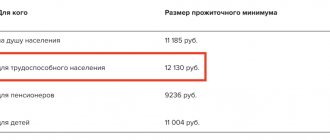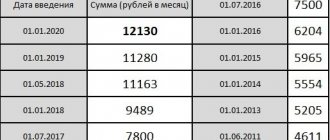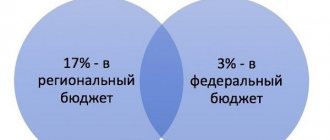20 Dec 2017
The minimum wage in St. Petersburg will change from January 1, 2018 and will be 17 thousand rubles.
The federal city of St. Petersburg, like any other subject of the Russian Federation, has the right to establish a minimum wage that is different from that registered in the country. The main point is that the regional minimum wage should never be lower than the minimum wage established at the federal level.
Application of the new minimum wage in St. Petersburg in 2018
The regional agreement of September 20, 2017 on the minimum wage in St. Petersburg for 2021 establishes the following minimum wage from January 1, 2021:
- for the minimum salary – 17,000 rubles;
- the tariff rate (salary) of a 1st category employee is 13,500 rubles.
13,500 rubles is less than the minimum wage due to the fact that this amount does not include social and incentive payments (Labor Code of the Russian Federation, Article 129).
In 2021, the minimum wage was at least 16,000 rubles. Accordingly, the minimum wage in 2021 in St. Petersburg will increase by one thousand rubles. At the same time, the tariff rate (salary) of a 1st category employee did not change and remained at the same level – 13,500 rubles.
Minimum wage in St. Petersburg from May 1, 2021: what changes?
With the adoption of the new version of Law No. 82-FZ on 03/07/2018, the federal minimum wage as of May 1, 2021 became equal to the subsistence level of working-age Russians (as of the second quarter of 2021) and amounted to 11,163 rubles. Has this affected the St. Petersburg minimum wage?
Let us recall that before the approval of the minimum wage of St. Petersburg in 2021, in the city of federal significance, a minimum wage limit of 16,000 rubles was applied. at the same rate 13,500 rubles. for first-class workers (Regional Agreement dated September 12, 2016). The cost of living in St. Petersburg for able-bodied persons was 11,868.20 rubles in the fourth quarter of 2021, and 11,903.10 rubles in the first quarter of 2021. (Resolutions of the Government of St. Petersburg No. 177 of March 13, 2018 and No. 390 of May 18, 2018). As you can see, the size of the regional minimum wage is significantly ahead of not only the size of the federal minimum wage, but also the regional cost of living. In this regard, the minimum wage in St. Petersburg has not been revised since May 1, continuing to operate in the amount established from 01/01/2018 - 17,000 rubles.
Minimum wage in 2021 in St. Petersburg and employers
Note that the minimum wage established at the federal level is mandatory for all employers, but this standard does not apply to the regional minimum wage. This is stated in the Labor Code of the Russian Federation (Article 133.1).
That is, the employer has the right, within thirty days after the publication of the proposal to join the regional agreement on the minimum wage, to send a refusal to the authorized body. For the northern capital, such an authorized body is the Committee on Labor and Employment.
If a refusal is not provided, employers are required to apply the regional minimum wage. Based on Part 6 of Article 5.27 of the Administrative Code, if the wages of employees are less than the established minimum wage, this threatens the employer with a fine of up to 50 thousand rubles.
Hourly wages in St. Petersburg
Taking into account a standard working day, week and year, with an average salary in St. Petersburg, the cost of a working hour is estimated at about 320 rubles, for a salary at the minimum wage level - about 114 rubles per hour , which is less than a thousand per day.
For comparison, taking into account currency conversion: in Germany the cost of a working hour at the minimum level is 654 rubles, in the UK – 660 rubles.
In St. Petersburg, measures are gradually being taken to encourage young professionals. The project for the end of 2021 includes additional payments to graduates of universities and colleges, valid for two years.
Overtime hours worked must be taken into account in a special manner and are compensated in the form of additional pay and the provision of additional days of rest. The first two hours must be paid at least one and a half times the rate, the third and fourth – at double the rate. This is a nationwide norm.
Living wage and minimum wage in St. Petersburg
The concepts of “minimum wage” and “living wage” should not be confused. St. Petersburg is one of the Russian regions where the minimum wage is higher than the subsistence level. The cost of living is published on the official website of the city administration.
The cost of living in the city of St. Petersburg for various categories of the population as of the 3rd quarter of 2021 is as follows:
- per capita – 10,791.60 rubles;
- children – 10,403.20 rubles;
- pensioners – 8612.20 rubles;
- working-age population – 11,868.20 rubles.
This indicator was approved by Decree of the Government of St. Petersburg No. 963 dated November 27, 2021.
Federal minimum wage
From July 1, 2021, the minimum wage is RUB 7,500. per month.
From July 1, 2021, the minimum wage is RUB 7,800. per month.
From January 1, 2021, the minimum wage will be RUB 9,489. per month.
From May 1, 2021, the minimum wage will be 11,163 rubles. per month.
Minimum wage (minimum wage) is a legally established minimum used to regulate wages (including influencing salary increases), as well as to determine the amount of temporary disability benefits, minimum maternity benefits, benefits, etc. The minimum wage depends to some extent degrees from the subsistence level.
Growth dynamics of the minimum wage 2000-2018
|
From May 1, 2021, the minimum wage is 11,163 rubles (+17.6%), i.e. is equal to the federal subsistence minimum for workers (Federal Law dated 03/07/2018 No. 41-FZ).
This might also be useful:
- The minimum wage and the cost of living are planned to be equal in 2021
- How to bypass 54-FZ
- Increasing K1 for UTII in 2021
- Tax calendar for 2021 for individual entrepreneurs
- Production calendar for 2021
- Increasing the minimum wage in 2021
Is the information useful? Tell your friends and colleagues
Dear readers! The materials on the TBis.ru website are devoted to typical ways to resolve tax and legal issues, but each case is unique.
If you want to find out how to solve your specific issue, please contact the online consultant form. It's fast and free!
Average salaries by profession in St. Petersburg
Due to the large number of diverse companies attracting various sources of funding, in St. Petersburg people can often receive unequal amounts of remuneration for similar work. A classic example is a cleaner, who requires minimal skills to perform her job functions. The salary of such an employee in a budget organization may be close to the subsistence level. At the same time, there are companies where cleaners, with appropriate experience, can receive amounts exceeding average salaries.
Examples of average salaries in St. Petersburg for 6 months of 2021 for some professions:
| Profession | Average salary, rubles | |||
| Total | including by types of ownership of organizations | |||
| federal | subjects of the Russian Federation | municipal | ||
| Average salary of junior medical personnel | 48 579,6 | 49 179,3 | 48 300,0 | – |
| Average salary of doctors and employees of medical organizations with higher medical degrees | 101 715,6 | 104 920,8 | 100 843,0 | …1) |
| Average salary of scientific staff | 98 838,9 | 98 834,7 | 99 316,5 | – |
| Average salary of teaching staff | 58 439,6 | 82 171,0 | 58 189,8 | – |
| Average salary of teaching staff of preschool educational organizations | 51 448,6 | 51 448,6 | – | – |
| Average wages of employees of state cultural institutions | 57 856,5 | 64 959,8 | 51 213,9 | 40 900,2 |
| Average salary of paramedical (pharmaceutical) personnel | 56 094,3 | 55 266,4 | 56 322,7 | – |
However, in general, certain trends can be seen in typical pay rates.
For any general job there is a market rate of pay per hour, which in most cases fluctuates within a certain range.
The lowest paid areas of employment are those that require neither qualifications nor experience. They are often visited by students and the elderly. Very often, in fact, this work does not take up a full working day.
In hotels and professional cleaning services, people easily earn 60-70 thousand. Promoters and advertisers can earn 10-15 thousand . Low salaries for entry-level cashiers, waiters, and couriers.
The lower limit in St. Petersburg is around 17,000.
Specialists in budgetary institutions have very low salaries: from a librarian to a typical research assistant.
Psychologists and school teachers at the beginning of their careers earn from 15,000 - below average.
A nurse and paramedic earn in St. Petersburg, as a rule, from 20,000. Salespeople and sales consultants start with amounts in the region of 17,000. Salaries of loaders start at about 20,000, however, with the growth of responsibilities here you can get much more over time .
Call center operators receive very different salaries depending on the workload and the specifics of the service: from 12,000 to 50,000.
“Minimum wage”: what is it for?
The minimum wage is primarily necessary in order to protect domestic workers from arbitrariness on the part of employers. In accordance with the requirements of current legislation, when calculating for a fully worked month, an employee cannot receive an amount less than the established minimum wage (in St. Petersburg, from January 1, 2021, we will consider the value later)
However, here we are not talking about the salary, but about the full amount given to the employee. Accordingly, they include:
- Salary, the amount of which is specified in the employment contract or agreement;
- The amount of compensation payments due to the employee (in accordance with regulations and collective agreements);
- The amount of incentive payments due to the employee.
Thus, when comparing the income actually paid by the employer to the employee, the total amount of money issued to the employee is taken into account.
The basic minimum wage (in St. Petersburg for 2021 the value will be determined below) is set at the federal level. From time to time, due to the influence of inflationary processes, the value of this indicator requires adjustment. The last change in the federal minimum wage occurred on July 1, 2021. During this period, the minimum wage increased by 300.00 rubles and amounted to 7,800.00 rubles.
If there is an economic need, regions of the country have the opportunity to set the minimum payment on their own. However, the regional minimum wage cannot be lower than the federal one. Accordingly, today the constituent entities of the Federation can set a “minimum wage” of at least 7,800.00 rubles.
Traditionally, Moscow, St. Petersburg, the Far East and Kamchatka are recognized as regions with the highest minimum wage indicators.
If a subject of the Federation has made an objective decision to increase the minimum wage in force in the region, this decision requires mandatory official publication.
However, not every employer will be happy about the need to increase the salaries of their employees. In this regard, the regulatory framework provides for the possibility of voluntarily abandoning the use of the regional minimum wage (St. Petersburg 2021 will be discussed later) in favor of the federal one. This must be done in written format within one month from the date of publication of the decision on maintaining the regional minimum wage.
New information about the minimum wage in 2021
What is the minimum wage level in the “northern capital”?
St. Petersburg is rightly recognized as one of the most expensive cities in Russia. High prices for goods and services of everyday demand predetermined the increased value of the “minimum wage” compared to the federal indicator.
The minimum wage in St. Petersburg in 2021, as well as in other periods, is established in accordance with Law No. 577-114, dated 2011. The normative act states that the indicator is determined in relation to the subsistence minimum. If it increases, the minimum wage is raised; if it falls, it is left at the same level.
The value of the “minimum wage” is considered established if three parties to the negotiations are in favor:
- Leningrad Federation of Trade Unions;
- Union of Industrialists and Entrepreneurs of St. Petersburg;
- city executive power.
The adopted decision is enshrined in regional legislation and published on the official website of the executive branch.
The minimum wage 2021 St. Petersburg applies to organizations operating in the city. It is not relevant for budgetary structures and companies financed from the state treasury.
The regional “minimum wage” is a guarantee for city workers that they will not receive labor income below the established value. The indicator established in St. Petersburg is used exclusively to control salaries and is not used to calculate disability benefits, maternity benefits, and individual entrepreneur insurance premiums. For these purposes, you need to take federal significance.
Employers' liability
If the employer does not send a refusal and does not increase earnings to the regional level established from January 1, 2021, then sanctions are possible.
Let's list the administrative fines under Article 5.27 of the Code of Administrative Offenses of the Russian Federation:
- for an official (for example, a director) – from 10,000 to 20,000 rubles;
- for an individual entrepreneur (employer) – from 1000 to 5000 rubles;
- for an organization (legal entity) – from 30,000 to 50,000 rubles.
If the organization commits a violation again, the liability will be stricter:
- for an official (for example, a director) – a fine of 20,000 to 30,000 rubles.
- or disqualification for a period of one to three years;
- for individual entrepreneurs – a fine from 10,000 to 30,000 rubles;
- for a company – a fine from 50,000 to 100,000 rubles.
The issue of administrative punishment of violators is considered by the labor inspectorate or the court (Parts 1, 2 of Article 23.1, 23.12 of the Code of Administrative Offenses of the Russian Federation). Also keep in mind that if you refuse the regional minimum wage, the employer may be called to the Federal Tax Service for a salary commission.
Read also
21.11.2017
A course has been taken to move closer to the living wage
The minimum wage should not be less than the subsistence level of the working population (Article 133 of the Labor Code of the Russian Federation). However, the cost of living for the second quarter of 2017 is 11,163 rubles, and the federal minimum wage is only 7,800 rubles. A special law should determine the procedure and period during which the authorities are obliged to increase the minimum wage (Article 421 of the Labor Code of the Russian Federation). And they finally decided to pass this law.
The matter has reached the final stage of raising the minimum wage to the minimum subsistence level established in Russia. For these purposes, Federal Law No. 421-FZ dated December 28, 2017 was signed and entered into force on January 1, 2021:
- from January 1, 2021 – up to 85% of the subsistence level of the working-age population;
- from January 1, 2021 – up to 100%.
According to the bill, starting from 2021, each year the minimum wage will be set in the amount of the federal subsistence level for the 2nd quarter of the previous year. At the same time, the minimum wage for the next year cannot be less than the established minimum wage.
The subsistence minimum is the cost of a conditional consumer basket, which includes a minimum set of food products, non-food products and services that are necessary to ensure human life. The cost of living also includes mandatory payments and fees.
The cost of living is approved at the end of each quarter, using numerous statistical data, including the inflation rate, to determine it. The federal subsistence minimum is set by the Government of Russia, and regional minimums are set by regional governments.
What does the regional minimum wage mean for employees and employers?
In Art. 133.1 of the Labor Code of the Russian Federation states that Russian regions have the right to determine and legislate their own minimum wage value that exceeds the federal figure. The corresponding decision is made based on the characteristics of the socio-economic situation in the subject.
The legislation regulates that the minimum wage in St. Petersburg 2018 applies to all employers operating in the region, with the exception of budgetary institutions that exist at the expense of federal funds. Compliance with the “lower bar” is ensured through the financial resources of commercial employer structures or the budget of the subject.
The “minimum wage” at the regional level is established if the agreement of the three parties to the social partnership is reached:
- trade union organizations;
- associations of employing firms;
- regional authorities.
The agreements reached are enshrined in a regional agreement.
When the decision is made, information about the minimum wage is published in the media determined by the Charter of the region, and the authorities invite employers who did not participate in the discussions to join the initiative (Article 133.1 of the Labor Code of the Russian Federation).
Theoretically, the “offer” received from above can be rejected. To do this, it is necessary to send a letter to the executive body of the constituent entity of the Russian Federation explaining the reasons for disagreement. The reasons for non-joining the regional initiative must be documented, for example, a development plan indicating the timing of reaching the local “minimum wage” must be attached. In fact, it is impossible to stay away from the innovation; it is only possible to delay the increase in salaries for hired personnel.
Entrepreneurs of St. Petersburg and other constituent entities of the Russian Federation have 30 calendar days from the date of publication of the agreement to refuse to join the agreement. Practice shows that most businessmen do not meet deadlines due to the fact that they learn about the decision made late: only after penalties have been applied to them.
Practice shows that the regional agreement on the minimum wage in St. Petersburg 2018 covers the vast majority of employers in the region. They are obliged to find resources to increase their payroll from their own funds. Budgetary structures financed from the state treasury remain outside the initiative.
Increasing the minimum wage in 2021
Minimum wage from January 1, 2021: table by region
Below we present a table with the minimum wage from January 1, 2021 (by region). Also, for convenience, the values are broken down by federal district.
| Region | Region code | Minimum wage (RUB) | Rationale |
| Central Federal District | |||
| Belgorod region | 31 | The cost of living of the working-age population, determined for the third quarter of the previous year (9489) | Tripartite agreement between the regional association of trade union organizations, employers' associations and the government of the Belgorod region for 2017–2019, art. 1 of the Law of June 19, 2000 No. 82-FZ |
| Bryansk region | 32 | 9489 | Regional agreement between the government of the Bryansk region, the public organization "Federation of Trade Unions of the Bryansk Region" and associations of employers of the Bryansk region on the minimum wage in the Bryansk region for 2021 dated December 21, 2021, art. 1 of the Law of June 19, 2000 No. 82-FZ |
| Vladimir region | 33 | 9489 | Regional agreement of the administration of the Vladimir region of August 8, 2021, art. 1 of the Law of June 19, 2000 No. 82-FZ |
| Voronezh region | 36 | The cost of living of the working-age population. In this case, the tariff rate (salary) of a 1st category employee should not be less than 9489 | Agreement of employers' associations of the Voronezh region dated February 1, 2021; Art. 1 of the Law of June 19, 2000 No. 82-FZ |
| Ivanovo region | 37 | The cost of living of the working-age population, determined for the third quarter of the previous year (9489) | Agreement on the regulation of social, labor and related economic relations between the government of the Ivanovo region, the regional association of trade union organizations, the regional association of employers for 2015–2017 dated December 26, 2014 No. 109-s; Art. 1 of the Law of June 19, 2000 No. 82-FZ |
| Kaluga region | 40 | Subsistence level of the working-age population per month (9489) | Kaluga Regional Tripartite Agreement between the Territorial Union of Trade Union Organizations "Kaluga Regional Council of Trade Unions", regional associations of employers and the government of the Kaluga Region for 2017–2019; Agreement on the minimum wage in the Kaluga region of September 16, 2013; Art. 1 of the Law of June 19, 2000 No. 82-FZ |
| Kostroma region | 44 | The cost of living of the working-age population. In this case, the tariff rate (salary) of a 1st category employee should not be less than 9489 | Agreement on amendments to the Agreement on social partnership in the sphere of labor between the administration of the Kostroma region, the Federation of trade union organizations of the Kostroma region and employers' associations of the Kostroma region for 2014–2016 and the extension of its validity; Agreement on social partnership in the field of labor between the administration of the Kostroma region, the Federation of trade union organizations of the Kostroma region and associations of employers of the Kostroma region for 2014–2016 dated January 15, 2014 No. 3-d; Art. 1 of the Law of June 19, 2000 No. 82-FZ |
| Kursk region | 46 | 9804 (9489) | Agreement between the administration of the Kursk region, the Union “Federation of Trade Union Organizations of the Kursk Region” and the Association of Employers “Union of Industrialists and Entrepreneurs of the Kursk Region” on the minimum wage in the Kursk region for 2021 dated December 20, 2021; Art. 1 of the Law of June 19, 2000 No. 82-FZ |
| Lipetsk region | 48 | 1.2 times the subsistence level of the working-age population for the fourth quarter of the previous year (9489) | Regional tripartite agreement for 2015–2017 between the administration of the Lipetsk region, the Federation of trade unions of the Lipetsk region, associations of employers of the Lipetsk region dated December 23, 2014 (together with the Regional agreement on the minimum wage in the Lipetsk region for 2015–2017) |
| Moscow | 77 | 18 742 | Moscow tripartite agreement for 2016–2018 between the Moscow government, Moscow trade union associations and Moscow employers' associations of December 15, 2015, Moscow government decree of September 12, 2021 No. 663-PP |
| Moscow region | 50 | 13 750 (9489) | Agreement on the minimum wage in the Moscow region between the government of the Moscow region, the Moscow regional association of trade union organizations and employers' associations of the Moscow region dated November 30, 2021 No. 118; Art. 1 of the Law of June 19, 2000 No. 82-FZ |
| Oryol Region | 57 | 10 000 (9489) | Agreement of the Government of the Oryol Region, the Federation of Trade Unions of the Oryol Region, the Association of Employers “Association of Industrialists and Entrepreneurs of the Oryol Region” dated February 2, 2021 No. 4; Art. 1 of the Law of June 19, 2000 No. 82-FZ |
| Ryazan Oblast | 62 | 9500 (9489) | Regional agreement on the minimum wage in the Ryazan region for 2021 dated December 21, 2021 No. 144-1, art. 1 of the Law of June 19, 2000 No. 82-FZ |
| Smolensk region | 67 | 9489 | Art. 1 of the Law of June 19, 2000 No. 82-FZ |
| Tambov Region | 68 | 9849 | Regional agreement on the minimum wage in the Tambov region dated July 19, 2021 No. 1, art. 1 of the Law of June 19, 2000 No. 82-FZ |
| Tver region | 69 | 9489 | Art. 1 of the Law of June 19, 2000 No. 82-FZ |
| Tula region | 71 | 13,000 (11,000 for state and municipal institutions) (9489) | Regional agreement on the minimum wage in the Tula region dated November 16, 2015 No. b/n; Art. 1 of the Law of June 19, 2000 No. 82-FZ |
| Yaroslavl region | 76 | In the amount of the subsistence level of the working-age population for the third quarter of the previous year (for employees of small and medium-sized enterprises - 9,640 rubles) (9849) | Regional agreement on the minimum wage in the Yaroslavl region dated December 24, 2015. |
| Northwestern Federal District | |||
| Arhangelsk region | 29 | 9489 | Art. 1 of the Law of June 19, 2000 No. 82-FZ |
| Vologda Region | 35 | 9489 | Art. 1 of the Law of June 19, 2000 No. 82-FZ |
| Kaliningrad region | 39 | 11 000 (9489) | Regional agreement on the minimum wage in the Kaliningrad region of April 22, 2021; Art. 1 of the Law of June 19, 2000 No. 82-FZ |
| Leningrad region | 47 | 10 850 (9489) | Regional agreement on the minimum wage in the Leningrad region for 2021 dated December 26, 2021 No. 20/C-16; Art. 1 of the Law of June 19, 2000 No. 82-FZ |
| Murmansk region | 51 | 14 281 (9489) | Appendix 3 dated November 29, 2021 to the Agreement on the minimum wage in the Murmansk region for 2015–2017 dated November 28, 2014; Agreement on the minimum wage in the Murmansk region for 2015–2017 dated November 28, 2014. |
| Nenets Autonomous Okrug | 83 | 14 260 (9489) | Agreement on the minimum wage in the Nenets Autonomous Okrug dated March 29, 2021; Art. 1 of the Law of June 19, 2000 No. 82-FZ |
| Novgorod region | 53 | The cost of living of the working-age population per month | Agreement to the Regional Agreement between the Union of Trade Union Organizations "Novgorod Regional Federation of Trade Unions", the Regional Association of Employers "Union of Industrialists and Entrepreneurs of the Novgorod Region" and the Government of the Novgorod Region "On the minimum wage in the Novgorod Region" dated January 13, 2021 No. 1; Regional agreement between the Association of Trade Union Organizations "Novgorod Regional Federation of Trade Unions", the Regional Association of Employers "Union of Industrialists and Entrepreneurs of the Novgorod Region" and the Government of the Novgorod Region "On the minimum wage in the Novgorod Region" dated December 26, 2014. |
| Pskov region | 60 | from 9489 to 11 450 | Agreement of the State Committee of the Pskov Region on Labor and Employment of the Population dated December 29, 2021 No. 375 |
| Republic of Karelia | 10 | The cost of living of the working-age population, established for the third quarter of the previous year (9489) | Order of the Government of the Republic of Karelia dated December 26, 2014 No. 811r-P (together with the Agreement on the minimum wage in the Republic of Karelia); Art. 1 of the Law of June 19, 2000 No. 82-FZ |
| Komi Republic | 11 | from 9489 to 10,000 | Regional agreement on the minimum wage in the Komi Republic of December 28, 2021 No. 149; Art. 1 of the Law of June 19, 2000 No. 82-FZ |
| Saint Petersburg | 78 | 16,000 rub. In this case, the tariff rate (salary) of a 1st category employee should not be less than 13,500 rubles. (9489) | Regional agreement on the minimum wage in St. Petersburg for 2021; Art. 1 of the Law of June 19, 2000 No. 82-FZ |
| Southern Federal District | |||
| Astrakhan region | 30 | 9489 | Art. 1 of the Law of June 19, 2000 No. 82-FZ |
| Volgograd region | 34 | 1.2 times the subsistence level of the working-age population (9489) | Agreement on the minimum wage in the Volgograd region dated July 5, 2021 No. S-272/15; Art. 1 of the Law of June 19, 2000 No. 82-FZ |
| Krasnodar region | 23 | Subsistence level of the working-age population per month (9489) | Regional agreement on the minimum wage in the Krasnodar Territory for 2012–2014 (as amended by the Decision of the Krasnodar Regional Tripartite Commission for the Regulation of Social and Labor Relations dated December 24, 2014 No. 5-4); Art. 1 of the Law of June 19, 2000 No. 82-FZ |
| Republic of Adygea | 01 | 9489 | Art. 1 of the Law of June 19, 2000 No. 82-FZ |
| Republic of Kalmykia | 08 | 9489 | Art. 1 of the Law of June 19, 2000 No. 82-FZ |
| Rostov region | 61 | 9489 | Rostov regional tripartite (regional) agreement between the government of the Rostov region, the Union of trade union organizations “Federation of Trade Unions of the Rostov Region” and the Union of Employers of the Rostov Region for 2017–2019 dated November 16, 2016 No. 12, art. 1 of the Law of June 19, 2000 No. 82-FZ |
| Republic of Crimea | 91 | 9489 | Agreement of the Crimean Republican Association of Trade Union Organizations “Federation of Independent Trade Unions of Crimea” dated August 24, 2015 No. b/n, art. 1 of the Law of June 19, 2000 No. 82-FZ |
| Sevastopol | 92 | 9489 | Regional agreement on the minimum wage in the city of Sevastopol |
| North Caucasus Federal District | |||
| Kabardino-Balkarian Republic | 07 | In the amount of the subsistence minimum of the working-age population for the fourth quarter of the previous year (9489) | Decision of the Kabardino-Balkarian Tripartite Commission for the Regulation of Social and Labor Relations dated May 23, 2021 No. 1; Art. 1 of the Law of June 19, 2000 No. 82-FZ |
| Karachay-Cherkess Republic | 09 | 9489 | Art. 1 of the Law of June 19, 2000 No. 82-FZ |
| The Republic of Dagestan | 05 | 9489 | Art. 1 of the Law of June 19, 2000 No. 82-FZ |
| The Republic of Ingushetia | 06 | 9489 | Art. 1 of the Law of June 19, 2000 No. 82-FZ |
| Republic of North Ossetia–Alania | 15 | 9489 | Art. 1 of the Law of June 19, 2000 No. 82-FZ |
| Stavropol region | 26 | The cost of living of the working-age population for the first quarter of the current year, starting from the next month after its establishment. Until such a value is established, the cost of living of the working-age population for the first quarter of the previous year (9489) is used. | Order of the government of the Stavropol Territory “On approval of the Agreement between the government of the Stavropol Territory, the territorial association of the Federation of Trade Unions and the Union of Employers “Congress of Stavropol Business Circles” for 2016–2018” dated February 17, 2021 No. 41-RP, art. 1 of the Law of June 19, 2000 No. 82-FZ |
| Chechen Republic | 20 | 9489 | Agreement between the Government of the Chechen Republic, the Republican Union “Federation of Trade Unions of the Chechen Republic” and the Republican Association of Employers “On the minimum wage in the Chechen Republic” dated June 27, 2021; Art. 1 of the Law of June 19, 2000 No. 82-FZ |
| Volga Federal District | |||
| Kirov region | 43 | 9489 | Art. 1 of the Law of June 19, 2000 No. 82-FZ |
| Nizhny Novgorod Region | 52 | 9500 (9489) | Decree of the government of the Nizhny Novgorod region, the Nizhny Novgorod regional union of trade union organizations "Oblsovprof", the association of employers "Nizhny Novgorod Association of Industrialists and Entrepreneurs" dated December 14, 2021 No. 849/389/A-565; Art. 1 of the Law of June 19, 2000 No. 82-FZ |
| Orenburg region | 56 | 9489 | Art. 1 of the Law of June 19, 2000 No. 82-FZ |
| Penza region | 58 | 9489 | Art. 1 of the Law of June 19, 2000 No. 82-FZ |
| Republic of Bashkortostan | 02 | 9489 Allowances and coefficients are accrued from above, after the salary is established (Resolution of the Constitutional Court of the Russian Federation of December 7, 2021 No. 38-P) | Agreement between the Government of the Republic of Bashkortostan, associations of employers of the Republic of Bashkortostan, Federation of Trade Unions of the Republic of Bashkortostan dated April 20, 2021 “On the minimum wage in the Republic of Bashkortostan”; Art. 1 of the Law of June 19, 2000 No. 82-FZ |
| Mari El Republic | 12 | 9489 | Additional agreement between the Government of the Republic of Mari El, the Union of Trade Union Organizations of the Republic of Mari El and the Republican Association of Employers on the minimum wage in the Republic of Mari El for 2021 dated November 11, 2016; Art. 1 of the Law of June 19, 2000 No. 82-FZ |
| The Republic of Mordovia | 13 | 9489 | Art. 1 of the Law of June 19, 2000 No. 82-FZ |
| Republic of Tatarstan | 16 | 9489 | Agreement between the Federation of Trade Unions of the Republic of Tatarstan, the Coordination Council of Employers' Associations of the Republic of Tatarstan, the Cabinet of Ministers of the Republic of Tatarstan on the minimum wage in the Republic of Tatarstan dated July 11, 2021 No. 255; Art. 1 of the Law of June 19, 2000 No. 82-FZ |
| Samara Region | 63 | 9489 | Art. 1 of the Law of June 19, 2000 No. 82-FZ |
| Saratov region | 64 | 9489 | Agreement on the minimum wage in the Saratov region dated May 27, 2021; Art. 1 of the Law of June 19, 2000 No. 82-FZ |
| Perm region | 59 | The cost of living of the working-age population | Agreement on the minimum wage in the Perm region for 2017–2019 dated November 11, 2021 No. SED-01-37-89; Art. 1 of the Law of June 19, 2000 No. 82-FZ |
| Udmurt republic | 18 | 9489 (including regional coefficient) | Regional agreement of the association of employers of the Udmurt Republic dated July 1, 2021; Art. 1 of the Law of June 19, 2000 No. 82-FZ |
| Ulyanovsk region | 73 | 10 000 (9489) | Additional agreement to the Regional Agreement No. 75-dp dated June 10, 2015 between the regional union “Federation of Trade Unions of the Ulyanovsk Region”, associations of employers of the Ulyanovsk region, the Government of the Ulyanovsk region on the minimum wage in the Ulyanovsk region dated January 25, 2021; Regional agreement between the Federation of Trade Union Organizations of the Ulyanovsk Region, associations of employers of the Ulyanovsk Region, the government of the Ulyanovsk Region dated June 10, 2015; Art. 1 of the Law of June 19, 2000 No. 82-FZ |
| Chuvash Republic | 21 | 9489 | Art. 1 of the Law of June 19, 2000 No. 82-FZ |
| Ural federal district | |||
| Kurgan region | 45 | 9489 | Agreement on the amount of the minimum wage in the Kurgan region dated November 8, 2021 No. 11/16; Art. 1 of the Law of June 19, 2000 No. 82-FZ |
| Sverdlovsk region | 66 | 9489 | Agreement of the Regional Association of Employers “Sverdlovsk Regional Union of Industrialists and Entrepreneurs” dated August 30, 2021 No. 151 |
| Tyumen region | 72 | from 9489 to 9950 | Additional agreement to the Regional Agreement on the minimum wage in the Tyumen region dated April 30, 2014; Additional agreement No. 4 dated August 31, 2021 to the Regional Agreement on the minimum wage in the Tyumen region dated April 30, 2014; Regional agreement on the minimum wage in the Tyumen region dated April 30, 2014; Art. 1 of the Law of June 19, 2000 No. 82-FZ |
| Khanty-Mansiysk Autonomous Okrug – Ugra | 86 | 9489 with the addition of a regional coefficient and a percentage bonus for work experience in the regions of the Far North and equivalent areas (but not lower than the subsistence level of the working-age population established in the district) | Tripartite agreement “On the minimum wage in the Khanty-Mansiysk Autonomous Okrug - Ugra” dated March 31, 2021; Art. 1 of the Law of June 19, 2000 No. 82-FZ |
| Chelyabinsk region | 74 | from 9489 to 9700 | Regional agreement on the minimum wage in the Chelyabinsk region for 2021 dated December 30, 2021 No. 63; Art. 1 of the Law of June 19, 2000 No. 82-FZ |
| Yamalo-Nenets Autonomous Okrug | 89 | 16,299 taking into account additional payments and allowances of a compensatory and incentive nature (9489) | Regional agreement of the government of the Yamalo-Nenets Autonomous Okrug, the Non-profit organization "Association of Employers of the Yamalo-Nenets Autonomous Okrug", the Territorial Association of Trade Union Organizations dated October 7, 2021; Art. 1 of the Law of June 19, 2000 No. 82-FZ |
| Siberian Federal District | |||
| Altai region | 22 | 9489 | Regional agreement on the minimum wage in the Altai Territory for 2016–2018; Art. 1 of the Law of June 19, 2000 No. 82-FZ |
| Transbaikal region | 75 | from 9489 to 11 490 | Regional agreement of the government of the Trans-Baikal Territory, the Federation of Trade Unions of the Trans-Baikal Territory, the Association of Employers of the Trans-Baikal Territory of October 17, 2012; Art. 1 of the Law of June 19, 2000 No. 82-FZ |
| Irkutsk region | 38 | from 9489 to 12 652 | Regional agreement on the minimum wage in the Irkutsk region dated January 26, 2021; Art. 1 of the Law of June 19, 2000 No. 82-FZ |
| Kemerovo region | 42 | One and a half times the subsistence level of the working-age population for the fourth quarter (9489) | Kuzbass regional agreement between the Federation of Trade Union Organizations of Kuzbass, the board of administration of the Kemerovo region and employers of the Kemerovo region for 2016–2018 dated January 25, 2016; Art. 1 of the Law of June 19, 2000 No. 82-FZ |
| Krasnoyarsk region | 24 | from 10,592 to 26,376 (9489) | Regional agreement on the minimum wage in the Krasnoyarsk Territory of December 23, 2021; Art. 1 of the Law of June 19, 2000 No. 82-FZ |
| Novosibirsk region | 54 | 10 000 (9489) | Regional agreement on the minimum wage in the Novosibirsk region dated November 29, 2021; Art. 1 of the Law of June 19, 2000 No. 82-FZ |
| Omsk region | 55 | 9489 | Regional agreement on the minimum wage in the Omsk region dated December 23, 2015 No. 106-RS; Art. 1 of the Law of June 19, 2000 No. 82-FZ |
| Altai Republic | 04 | 9729 (9489) | Regional agreement of the Government of the Altai Republic dated June 28, 2021; Art. 1 of the Law of June 19, 2000 No. 82-FZ |
| The Republic of Buryatia | 03 | 9489 | Art. 1 of the Law of June 19, 2000 No. 82-FZ |
| Tyva Republic | 17 | 9489 | Regional agreement on the minimum wage in the Republic of Tyva from July 1, 2021; Art. 1 of the Law of June 19, 2000 No. 82-FZ |
| The Republic of Khakassia | 19 | 9489 | Art. 1 of the Law of June 19, 2000 No. 82-FZ |
| Tomsk region | 70 | from 9750 to 16 500 (9489) | Regional agreement on the minimum wage in the Tomsk region for 2021 dated January 9, 2021; Art. 1 of the Law of June 19, 2000 No. 82-FZ |
| Far Eastern Federal District | |||
| Amur region | 28 | 9489 | Art. 1 of the Law of June 19, 2000 No. 82-FZ |
| Jewish Autonomous Region | 79 | 9489 with the addition of a regional coefficient and a percentage bonus for work experience in the southern regions of the Far East | Agreement on the minimum wage in the Jewish Autonomous Region between the government of the Jewish Autonomous Region, the Federation of Trade Unions of the Jewish Autonomous Region, the Regional Association of Employers of the Jewish Autonomous Region “Union of Industrialists and Entrepreneurs” dated December 31, 2015; Art. 1 of the Law of June 19, 2000 No. 82-FZ |
| Kamchatka Krai | 41 | from 16,910 to 19,510 taking into account compensation and incentive payments (9489) | Additional agreement No. 1 to the Regional Agreement “On the minimum wage in the Kamchatka Territory for 2021” dated December 16, 2021; Regional agreement on the minimum wage in the Kamchatka Territory for 2021; Art. 1 of the Law of June 19, 2000 No. 82-FZ |
| Primorsky Krai | 25 | 9489 | Art. 1 of the Law of June 19, 2000 No. 82-FZ |
| Magadan Region | 49 | from 19,500 to 21,060, including compensation and incentive payments (9489) | Agreement of the Government of the Magadan Region dated May 23, 2021 No. 2; Art. 1 of the Law of June 19, 2000 No. 82-FZ |
| The Republic of Sakha (Yakutia) | 14 | 17 388 (9489) | Regional agreement of the Federation of Trade Unions of the Republic of Sakha (Yakutia) dated June 27, 2021; Art. 1 of the Law of June 19, 2000 No. 82-FZ |
| Sakhalin region | 65 | from 15,150 to 20,200 rubles. (9489) | Agreement on the minimum wage in the Sakhalin region for 2021 dated December 22, 2021; Art. 1 of the Law of June 19, 2000 No. 82-FZ |
| Khabarovsk region | 27 | from 11,414 to 15,510 (9489) | Agreement on the minimum wage in the Khabarovsk Territory between the Khabarovsk Regional Association of Trade Union Organizations, the regional association of employers “Union of Employers of the Khabarovsk Territory” and the government of the Khabarovsk Territory dated March 24, 2016; Art. 1 of the Law of June 19, 2000 No. 82-FZ |
| Chukotka Autonomous Okrug | 87 | 9489 | Art. 1 of the Law of June 19, 2000 No. 82-FZ |








